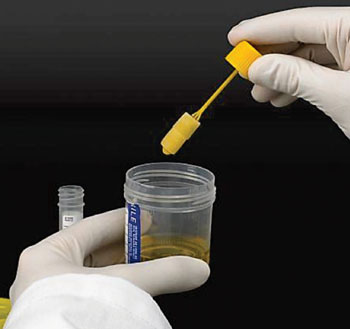Alternative Methods Compared for Urine Culture Collection and Transport
By LabMedica International staff writers
Posted on 24 Aug 2016
The ability to isolate and identify causative agents of urinary tract infections relies primarily on the quality of the urine sample that is submitted to the microbiology laboratory.Posted on 24 Aug 2016
Quantitation, identification and antimicrobial susceptibility testing is predicated on initial appropriate collection, ensuring that transport is performed in such a way as to preserve the right pathogen at the correct concentration, and third, that what is assumed to be the pathogen is actually causing an infection.

Image: The UriSwab is an advanced system for collection, transport and preservation of urine specimens from the collection site to the testing laboratory (Photo courtesy of Copan).
Microbiologists at the University of Alberta Hospital (Edmonton, AB, Canada) have reported a composite of several investigations comparing collection and transport on urine culture paddles, with a preservative urine sponge and a comparison of the urine sponge with a preservative transport tube as methods of preservation of urinary pathogens. Aside from the bedside issues of collection of mid-stream urines, samples from catheterized patients, and infants, there are concerns for transport of the sample to the laboratory to avoid overgrowth (or loss) of the causative organism.
The scientists used two devices as method of transport; the Becton Dickinson Urine Vacutainer, sometimes called a “Grey-Vac” (BD, Towson, MD, USA) and the Copan Uriswab (Copan Innovations, Brescia, Italy). In the Grey-Vac, urine is poured or transferred into the tube that contains a preservative pill and urine volume must reach the line on the tube (approximately 4 mL). In the Uriswab method, preservative is impregnated into the sponge, and the sponge is either dipped into the urine to saturate the sponge, or the patient may urinate directly onto the sponge. The Uriswab sponge holds approximately 1.5 mL. For collection of urine on the culture paddle, urine is collected into a sterile container. Morphotypes were quantitated and identification of uro-pathogens was made using either Vitek 2 (bioMérieux, Marcy-l'Étoile, France) GNI or GPI cards or with other validated non-automated methods.
The scientists reported that there were 25 more potential pathogen isolates recovered from the Uriswab than the culture paddle. Particularly for Escherichia coli, 10 additional isolates were identified from Uriswab, and there were no β-hemolytic streptococci recovered from the culture paddle. There were no significant differences in the number of different species recovered from both transport devices. An additional three E. coli were recovered at significant concentrations from Uriswab that were not observed in the Grey-Vac portion of the same urine sample.
The authors concluded that the isolation of urinary pathogens from sites both remote and close to the testing laboratory was enhanced by collection on the Uriswab compared both to culture paddle cultures and to the Grey-Vac preservative transport device. Costs for the culture paddle method become greater than either the Uriswab or the Grey-Vac because of the number of mixed cultures on the dip slides that need to be sub-cultured before determining if the isolates are significant to the infectious process. The study was published in the August 2016 issue of the journal Diagnostic Microbiology and Infectious Disease.
Related Links:
University of Alberta Hospital
BD
Copan Innovations
bioMérieux




 assay.jpg)









